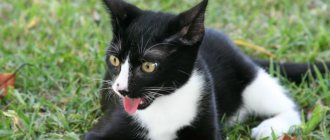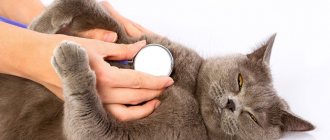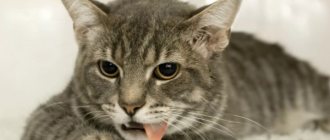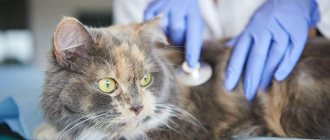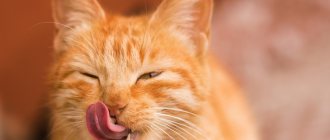The occurrence of breathing in a cat with an open mouth, accompanied by rapid inhalations and exhalations, is called shortness of breath. Shortness of breath is associated with a sharp lack of oxygen entering the body, causing brain hypoxia.
In veterinary medicine, as in human medicine, there are two types of dyspnea - provoked by physiological factors and pathological changes. Physiological shortness of breath is a reversible condition and, as a rule, does not require medical intervention. If shortness of breath occurs against the background of a serious illness, then it requires treatment to eliminate the underlying factor.
It is important to remember that shortness of breath that appears in a cat cannot be ignored and it is important to take this manifestation seriously. Rapid inhalation and exhalation indicates disturbances in the functioning of the body, sometimes threatening the health and even the life of the animal.
Pets breathing is normal
The respiratory process of mustachioed pets is similar to that of humans. When you inhale, air enters the nose and travels through the respiratory tract to the lungs. The carbon dioxide remaining after processing is removed along a similar route, but in reverse order.
An adult cat takes 20-40 breaths per minute, and a kitten takes 40-50. The breathing of a healthy animal is practically not audible, but its presence can be determined by the evenly and smoothly descending pectoral muscles.
Stress and psycho-emotional reasons
As a rule, stress and psycho-emotional reasons in cats do not often lead to breathing problems. But this statement is only partly true. There are several breeds of cats that are characterized by an overly emotional disposition and even some odd behavior:
- Persian cats.
- Siamese and crossbred animals based on them.
- “Good-natured giants”, Maine Coons, can be very aggressive.
Some representatives of these breeds are characterized by short-term (and sometimes not very short) outbursts of anger. In this case, the cat may lose control of itself, breathe hoarsely and quickly, and meow loudly and protractedly. Trying to calm him down costs yourself more. If this happens constantly, you need to consult a veterinarian about prescribing sedatives and medications to correct the animal’s behavior.
Why is a cat breathing heavily and frequently: non-dangerous reasons
Tachypnea, or rapid, heavy breathing, occurs in a cat when there is a lack of oxygen, or hypoxia. This condition is explained by 2 reasons: physiological and pathological.
Physiological causes are not life-threatening. These include various external and internal factors:
- Heat. A pet can overheat outside on a hot day or in a stuffy room with poor ventilation.
- Eating food quickly. Characteristic in the absence of saturation and prolonged fasting. Due to the too rapid absorption of food, breaths are taken in fits and starts, so the oxygen supplied with them is not enough.
- Fatigue after high physical activity. When performing intense movements, muscles require more oxygen, which is why shortness of breath often occurs while running.
- Overexcitement due to fear or aggression. In a state of stress, the body actively produces adrenaline, which speeds up the heart and the frequency of breathing. After calming down, the alarming symptoms disappear on their own.
- Hormonal changes. Occurs during estrus, pregnancy and childbirth. Treatment in these cases is not required, provided that the rest of the condition remains normal.
The risk group includes older cats and overweight cats. They get tired faster and often suffer from obesity due to inactivity.
What is this?
Respiratory failure (RF) in dogs and cats is a pathological condition in which the animal’s lungs do not provide normal blood gas composition or do, but it is achieved due to the intensive work of the external respiratory apparatus and heart, which reduces the functional characteristics of the body.
Important! Pulmonary insufficiency in cats and dogs is dangerous because without timely treatment it leads to acute and chronic diseases of the bronchopulmonary system, circulatory disorders, damage to the central nervous system and a number of other dangerous complications.
Heavy breathing in cats and cats is an alarming sign
With pathological causes, the problem lies in internal disorders, fraught with life-threatening complications. The cat is not only breathing heavily with its stomach, but it also looks unwell. The danger of the condition can be determined by the accompanying symptoms.
The main signs that a cat is suffocating
Suffocation caused by lack of oxygen is difficult to miss. It is accompanied by the following symptoms:
- shortness of breath;
- rapid heartbeat;
- general weakness;
- wheezing and sniffling;
- tachycardia;
- cough.
Most often, breathing problems occur in brachycephalic cats, that is, breeds with a flat face. Due to the specific structure of the skull, their nasal passages are narrower and shorter. Such animals inhale a more limited air flow throughout their lives and are much more susceptible to diseases affecting the respiratory tract.
Associated symptoms
In case of health problems, accompanying symptoms are added to the main symptoms. They depend on the cause of the ailment:
- Infectious diseases of the respiratory system (tracheitis, pneumonia, bronchitis). Lack of air occurs due to the active production of leukocytes, which clog the airways in the form of mucus. In addition to discharge from the eyes and nose, gastrointestinal upset (diarrhea, vomiting) and fever are noted.
- Injuries to the spine, ribs and respiratory system. The resulting fragments pinch the lungs, preventing them from fully opening. The cat experiences severe pain when touched or on a constant basis. With internal bleeding, blood comes out along with phlegm.
- Entry of a foreign body into the respiratory tract. Swallowing or inhaling foreign objects is accompanied by severe coughing, sneezing, salivation and lacrimation. Vomiting is also possible.
- Lungworms. These parasites lead to coughing, sneezing and internal bleeding.
- Neoplasms of various nature. Tumors in the respiratory tract interfere with the natural circulation of oxygen. The animal often coughs, wheezes and swallows saliva with effort. In the presence of oncology, there is an increase in sleep time, general weakness, weight loss and deterioration in coat quality.
- Cardiovascular diseases. The circulation of oxygen through the bloodstream occurs thanks to the heart, so any disruption in its functioning leads to difficulty breathing. From a lack of oxygen, the skin turns white and the mucous membranes turn blue. In severe cases of the disease, foam sometimes comes out of the mouth, and the cat itself may lose consciousness.
- Pulmonary edema. Develops as a result of injuries, heart pathologies, kidney and liver diseases. Accompanied by apathy, refusal to eat, blanching of the mucous membranes and noisy gurgling inside the chest.
- Poisoning. The body gets rid of toxins through vomiting and diarrhea. If strong poisons are swallowed, convulsions and pulse disturbances are possible.
Due to the overlap of some symptoms, making an accurate diagnosis on your own is very problematic. Without timely treatment, all of the diseases described above can lead to death from hypoxia, so if you suspect a pathology, it is better to immediately contact a veterinarian.
Asthma in pets
Another possible cause of periodic asthma attacks is asthma. It is easily recognized by a lingering cough. During the next exacerbation, the animal crouches to the floor and stretches its neck. This position is very similar to regurgitation of hairballs, so the disease is often ignored in the initial stages.
In most cases, the source of feline asthma remains unknown. Because of this, animals have to take medications on an ongoing basis. Glucocorticosteroids are most often used to suppress hypersensitivity of the upper respiratory tract.
Types of shortness of breath
It is possible to determine that a cat is suffering from shortness of breath.
The main features are:
- the appearance of specific whistling and wheezing sounds;
- the cat gasps for air with its mouth open, but the exhalation does not occur fully;
- the animal takes an uncharacteristic (forced) pose, tries to lie down, but begins to choke;
- breathing is not carried out in a natural way for a cat - through the mouth (this provokes pallor of the mucous membranes of the oral cavity and its dryness), cyanosis is noted.
Depending on the disease that provoked shortness of breath, there are several types:
- rare breathing – bradypnea. This type occurs when the functional characteristics of certain centers located in the brain are insufficient;
- rapid breathing - tachypnea, characterized by shallow inhalations and exhalations that occur during pathological blood conditions and febrile conditions.
The shortness of breath phase also has its own definition, so they distinguish:
- inspiration - heavy inhalation and normal exhalation;
- expiration - heavy exhalation and normal inhalation;
- mixed shortness of breath - characterized by heavy inhalation and exhalation.
How to provide first aid to a choking pet
First aid methods depend on the cause of the illness. In case of short-term disturbance, breathing often normalizes on its own, but in case of long-term disturbance, followed by cardiac arrest, the animal may require artificial respiration and indirect massage.
Basic steps
For physiological reasons, the pet simply needs to be given time to catch its breath and calm down. If overheating is to blame, be sure to offer a bowl of water and cool the areas where large vessels pass (neck, inner thighs, groin) with a cold compress. It is also recommended to open all doors and windows to create a draft.
If the cat is breathing heavily and wheezing, carefully examine his throat and check the integrity of the ribs. If you find a foreign body or injury, go to the veterinary clinic immediately. Self-help can result in accidentally pushing the found bone or other object even deeper, so it’s better not to take risks here.
Thus, the main actions are limited to normalizing body temperature, ventilating the room and calming the animal. The only exception is sudden cardiac arrest, as well as poisoning, provided its cause is known.
Is it possible to do artificial respiration?
If a cat loses consciousness and does not respond to light, then it requires urgent resuscitation. The rescue operation must begin within 2-3 minutes after the heart has stopped. In such a critical situation, it is very important not to panic, immediately call a veterinarian at home, and then strictly follow the following algorithm:
- Place the animal on its right side and extend its neck in line with the body. This will facilitate air flow.
- Clean the oral cavity from accumulated secretions with a napkin or gauze and close the mouth tightly. Removing mucus will help your pet avoid choking once breathing returns to normal.
- Inhale more air, place your curled palm on the cat’s nose and gently exhale into his nostrils. The frequency of inhalations depends on the size of the animal. With average settings, 20 times per minute is enough. The kitten will need more frequent but less intense repetitions.
- Check your pulse every 20 seconds. When breathing stops, the heart temporarily continues its work, so indirect massage is not required in all cases. If the heartbeat has really stopped, move on to the next step.
- Place one hand on the cat's chest, holding it between the thumb and the other four fingers.
- Perform several quick and rhythmic pressing movements with a break of 5 seconds, remembering to alternate them with artificial respiration. For every 30 movements there should be 2 breaths.
If possible, the rescue operation is best carried out in pairs. Once the heartbeat resumes, the animal cannot be moved, so at this point you just need to wait for the veterinarian.
Treatment of stomach discomfort
What to do if you have stomach discomfort?
To alleviate the condition you may need:
- diet;
- assistance with medicines.
To learn more
If discomfort or heaviness in the abdomen is associated with a lack of digestive enzymes, then taking enzyme preparations may be necessary. These drugs support digestion by delivering the same enzymes from the outside. Creon® is available in capsule form and is suitable for this task. The Creon® capsule quickly dissolves in the stomach, releasing hundreds of small particles - minimicrospheres1. Due to their small size, they evenly cover the food in the stomach to help in the digestion of its volume. This helps the body obtain the necessary nutrients from food and cope with symptoms such as heaviness and discomfort in the abdomen, bloating, and gurgling. This mechanism of action distinguishes Creon® from similar drugs in tablet form.
A tablet is an indivisible form of release that cannot be properly mixed with food in the stomach, and therefore cannot help in its complete digestion. The idea that a tablet can be crushed is erroneous, since this will lead to a breakdown of the protective coating of the drug, and the enzyme will simply die in the stomach.
You can find out more about the differences between Creon® and other drugs here.
In the fight against heaviness or discomfort, as a rule, 1 capsule of Creon® 100001 helps. Creon® capsules are easy to use: if necessary, you can open them and mix minimicrospheres with food or juice1. This way you can individually select the dose, which is especially important for young children, for whom Creon® is approved from birth1.
When is a vet visit necessary?
If you have certain symptoms, it is better not to waste time on self-examination. These include:
- rapid deterioration of the condition or lack of improvement within 3 hours;
- severe wheezing and gurgling in the chest;
- the appearance of pain when touching or coughing, accompanied by a plaintive meow;
- copious discharge of mucus from the nose or mouth;
- pale or blue discoloration of the skin and mucous membranes;
- increase or decrease in heart rate;
- convulsions;
- loss of consciousness.
Particular attention should be paid to children, elderly and pregnant animals. If the kitten is breathing heavily, then it should be taken to the veterinary clinic even in the absence of the listed symptoms. Due to fragile immunity, pets often get sick with complications up to a year old, so in such a situation it is better to play it safe.
In addition to visual inspection and palpation (palpation), a blood test, ultrasound, x-ray and ECG may be required to make a diagnosis. The list of medications will depend on the pathology found:
- antibiotics and antivirals that fight infectious agents;
- anthelmintics that destroy parasites;
- cardiotonics and vasopressors, which reduce the volume of circulating blood and increase the force of heart contraction;
- diuretics, facilitating the removal of excess fluid;
- glucocorticosteroids, eliminating allergies and inflammatory processes;
- sorbents that stimulate the removal of toxins.
In case of poisoning, an antidote may be required. Surgery is used when injuries, deep-lying foreign bodies and neoplasms are detected. If at the time of treatment the cat is in serious condition, then it can be placed in an oxygen chamber.
What will the veterinarian do if the kitten is breathing heavily?
When a kitten is seen by a veterinarian due to rapid breathing, specialists usually carry out the following procedures:
— Questioning the owner about the time when rapid breathing was noticed, the presence or absence of associated problems and possible natural causes.
— Visual examination of the animal, during which the doctor determines whether the body is dehydrated, what condition the mucous membranes are in, etc.
— Temperature measurement.
— Detection of helminthic infestation.
— Prescribing the necessary additional laboratory tests. For example, a blood test to rule out anemia or infectious diseases.
— Referral for an ultrasound or x-ray if there is a suspicion of heart disease or other internal organs.
— A puncture of the chest wall (thoracentesis), which allows you to determine whether there is excess air or fluid in the chest cavity. Used only in extreme cases.
